

Escallonia is a shrub that has very beautiful flowers and is thus very ornamental.
Key Escallonia facts
Name – Escallonia
Family – Escalloniaceae
Type – shrub
Height – 3 to 10 feet (1 to 3 m)
Exposure – full sun
Soil: draining – Foliage: evergreen – Flowering: end spring → mid-summer
The planting, care and pruning greatly impact the flowering and the proper growth of Escallonia shrubs.
Best is if you choose to plant your escallonia in fall to favor root development before winter hits, and ensure proper growth in spring.
You can also plant in spring but make sure that the young shrub has sufficient water at the beginning.
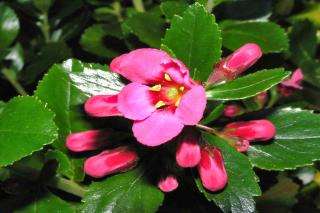 Favor locations that are well-endowed with sun to boost the escallonia’s beautiful blooming.
Favor locations that are well-endowed with sun to boost the escallonia’s beautiful blooming.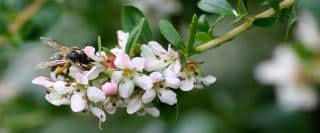
Regular pruning will also make foliage even denser, which will increase the blooming.
At the end of winter to re-balance the shape and at the end of summer, after the blooming to prune a bit more severely.
Escallonia is a shrub for which the adding of fertilizer and water helps favor growth. It doesn’t need any specific fertilizer, any all-purpose fertilizer will do –natural ones such as rich mulch are particularly relevant.
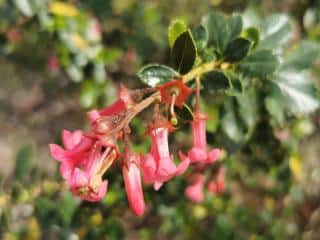
New branches will sprout out from leaf nodes lower down on the stem. This both makes your shrub bushier and new flowers appear on these, too.
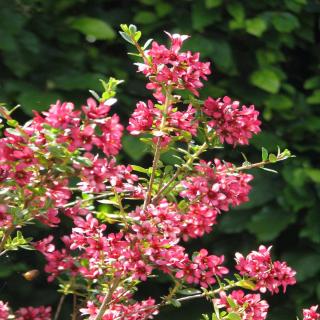
Its small bunches of flowers are a boon to the bees during the entire summer.
It is also much appreciated for its shiny foliage that is evergreen in winter.
Try to choose a spot that is sheltered from wind and rather warm, it will reach its entire potential during summer especially if you provide it with organic fertilizer in spring.
In a flower bed or a hedge, it fits perfectly well in both.
Escallonia comes in different sets of flowers and hedges depending on the variety, here are several cultivars that particularly appealed to us:
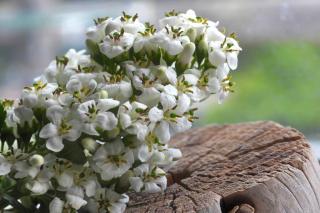 E. iveyi – An escallonia that boasts a nice white-colored blooming.
E. iveyi – An escallonia that boasts a nice white-colored blooming.A fun cultivar that is perfect for container growing is the Escallonia ‘Pink Elle’: it’s a dwarf variety, meaning it won’t ever grow any taller than 3 feet/1 meter.
See also:
For planting, avoid winter freezing at all costs!
I have an escallonia rubra which has grown and flowered beautifully this year. The petals have started to fall off some flowers and I’m left with a green star shape. Where abouts do I deadhead the flower? Thank you in advance
Hi Leah, I updated the article to include a paragraph on how to deadhead escallonia. In short, snip the whole tips off of branches to get even more branching and blooming!
My Rubra Macrantha is a hedge about 8 feet high but has been suffering for the last two years from yellowing of leaves and black spot and has a lot of bare patches now. Should I cut it back to it re-establish and at what time of year should I do that? Live in North of Scotland.
Hi David, it sure sounds like your Escallonia has depleted its growing area. Having scoured the soil for a long time, those nutrients it needs most have now gone lacking. Now much weaker, it falls sick and can’t regenerate as well. It’s fairly common with hedge shrubs, especially since putting the trimmings “back into the soil” isn’t often practiced. All the nutrients in the trimmings aren’t recycled back into the soil.
There are two options for you, and you can do both in parallel if you so wish:
– first, re-fertilize the soil. Start the practice of returning trimmings back near the foot of the plant (find a sturdy shredder for that. Note that since you mentioned black spot, you’d better compost everything for a full year before returning it under the same plants. In the meantime, use any other type of plant mulch. For the next two years, spray any nutrient-rich fermented tea on the ground every month or so during the growing season. After two years, you’ll be fine with spraying it twice a year only.
– second, consider varying your hedge by replacing bare/dead/sick spots with another species altogether. This has many advantages: different nutrient drain on the soil (each plant has different needs), less contamination since diseases have trouble hopping over non-host species, and, if you choose them adequately, you can even get flowers in different seasons. Not to mention the boon for biodiversity. It’s called a mixed hedge and once it’s planted, it isn’t any more work than a regular single-species hedge. For inspiration, here’s a list of 12 shrubs that can be planted alongside each other.
You could plant these new shrubs in (or replace the dead ones with fresh escallonias) this spring; just make sure it won’t freeze anymore.
I hope this helps!
Thank you for the reply, and I shall certainly work on improving the fertilisation, one question remains unanswered – should I cut it back to help regeneration and at what time of year should I do that?
You could definitely cut it back to regenerate it. Since this is a rather heavy pruning, it would be best to go at it at the end of the summer, once the flowers have wilted away. This gives wounds time to cure before winter.
On old hedges, it’s worth mentioning that how you prune is important. The hedge should have a “pyramid” shape, not a “funnel” shape. It should be wider at the bottom than at the top. Growth naturally happens more at the top because there’s more light, but this blocks the sun from reaching lower down, hence sparse and bare spots. So don’t prune “vertically”, but try to trim it inwards as you go up. You’ll want the base to be wider than the top by about 2-4 inches for every yard (5-10 cm for every meter).
Hello
My escallonia has been thriving the last 2 years, growing stems with lush foliage. Just before winter it has a growth spurt of wooden stems with the leaves still tiny if any at all yet formed? Will the leaves grow? It looks weird just have these woody stems growing that lack fully grown leaves?
Hello Tamara! It may be that this year, the season was particularly nice for the shrub: the usually weak Autumn growth spurt was instead very strong… and then the cold hit and slowed the growing. It happens this way when shrubs aren’t exactly native to the area, sometimes different varieties react differently even though they’re the same species.
As for what to do with these near-bare stems, it’s up to you: if you leave them, in Spring they’ll sprout fresh stems from each leaf node: lots of flowers and growth to be expected, but the shrub may get large very fast. If you prefer, you can cut them back: then, in Spring again, it’ll take a bit longer for new twigs to grow and the shrub will stay compact longer. Blooming won’t be affected if you cut, so it really depends on whether you have the space to let it grow or not – and if you can bear the spindly look during those long winter months!
Our Escallonia Elle has only produced four flowers. How best to prune for next year to assist the growth. Thanks. Roger
Hi Roger, normally you’d prune right after the flowers have died and wilted off. Simply snip the branches lower down the stem. New growth will tend to sprout from the buds closest to the tip, so the height at which you cut it and the direction the buds are facing will give you next year’s growth. Try to get a dense, roundish shape, if you can, by snipping the stems that jut out to the side and those that stand alone.
Normally, on the “Elle” (a laevis variety), flower buds form on the tip of stems. These form during the Summer after the blooming. At this point, Summer is nearly halfway spent, I’m not sure clipping stems will lead to new blooms for next year, but it’s worth a try since all you had this year was 4 flowers! So have fun snipping each and every stem to bring the shrub closer to the dense, round shape: with luck, all the new growth will bear blooms next year! Make sure to provide enough fertilizer and water after this pruning, since the plant will need help.
For next year, remember to prune the shrub right after the blooming: that way, new stems have all Summer to grow and mature for the following Spring.
Gaspard,
Thanks for your helpful advice.
I greatly appreciate helpful websites. We lost our landscaping in Sept. wildfires. It has been very difficult trying to find plants that have similar needs, that are long-blooming, etc. At our house in zone 9b, the backyard is basically full sun except for late afternoon from the house and a fence However, in the front a flowering tree shades the front from late spring until the leaves drop. The the area is in full sun all winter. This is a bit crazy, because the space is sunny when things aren’t growing and shady when they are. Does this mean I need to plant shade-preference plants or are sun-loving plants generally okay with summer shade? Most plant descriptions don’t include this kind of situation. I’d appreciate your guidance.
Hi Sharon, good question. Overall, plants are dormant in winter, meaning that even when they have water, sun, and nutrients, they still don’t grow because usually the temperature is too low, or has been low for a while even if on one particular day temperatures are higher. Some plants actually require cold weather as a part of their development, for instance the olive tree needs a cold, dormant period for its flowers to develop properly. Other plants aren’t as dormant: for instance, ivy will keep on growing even over winter, albeit much more slowly.
When gardeners talk about full sun or shade, they mean this for the time when the plants aren’t dormant. Basically, a “full sun” plant, if in the shade all day during Summer, won’t develop very nicely, or won’t bloom as much. However, a “shade plant” will do fine in that case. Sometimes it’s enough for the plant to get three or four hours of sun, for instance in the morning or afternoon. You’ll notice that one side of your garden will always bloom one to two week earlier than the other side if you’ve got hedges, fences or trees blocking the light out, even if you’ve planted exactly the same bulbs or whatnot.
So in your case, the most bountiful growth and flowering will come from shade-loving plants. You can also plant a few flower bulbs of the same type in different corners of the garden: the spot where they sprout out first after winter gets most light and can probably welcome a few “full sun” plants that can get a head start before the shade from the tree covers everything.
And I’m sorry for the loss due to the wildfires, that must have been quite a scare and now a challenge! Remember not to plant anything that is considered a fire risk, but I’m sure you’ve thought of that already…
My pink elle has finished flowering and has left small spikes where the flowers were, should I cut these off
Hello Jennifer, these are seed pods forming. In each one, you might have up to four seeds. If you’re interested in sprouting them next spring, you can leave a few on your shrub to mature. But you can also simply prune them off as you go about pruning the escallonia, since now is the best time to do it. Cutting off all the seed pods will help the plant focus on growing new branches and roots, which will make it look more lush and dense, and will guarantee even more flowers next year!